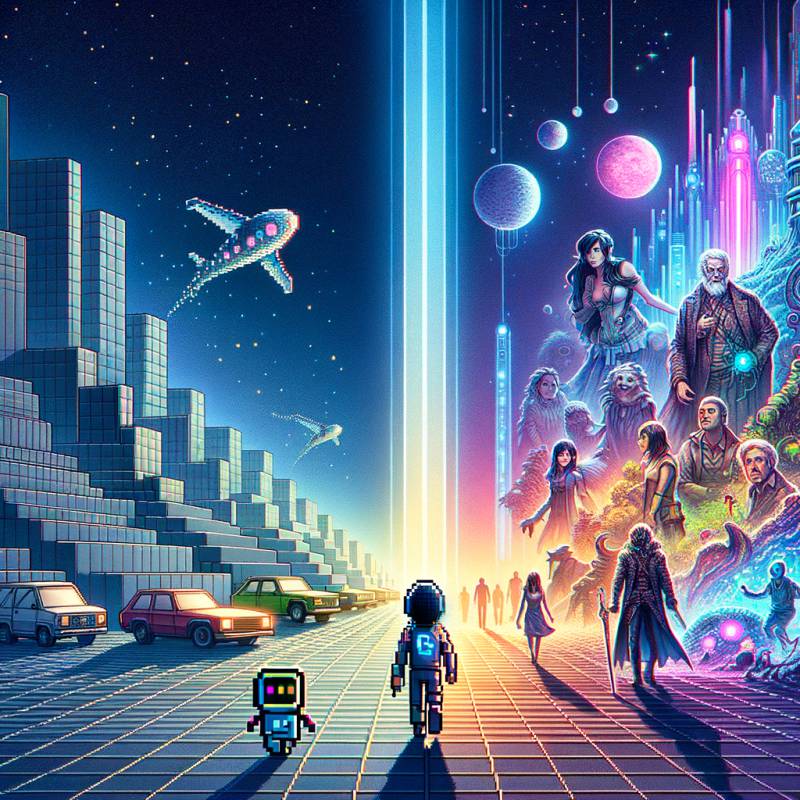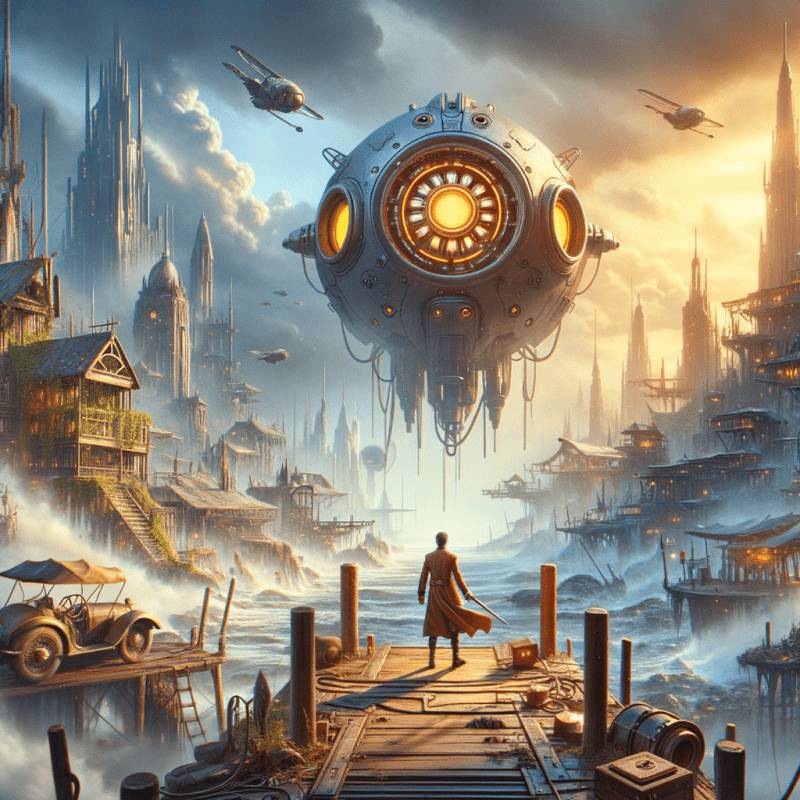Exploring the Evolution of Sci-Fi in Video Games: A Journey through Virtual Worlds
In the realm of video games, the genre of science fiction has always held a special place. It’s a genre that has consistently pushed the boundaries of imagination, transporting players into futuristic landscapes and alien worlds, and introducing them to advanced technologies and extraterrestrial life forms. The evolution of sci-fi in video games is a fascinating journey through virtual worlds, a journey that has mirrored the advancements in technology and the changing tastes of gamers.
In the early days of video gaming, sci-fi was a simple affair. Games like “Space Invaders” and “Asteroids” offered rudimentary depictions of space exploration and alien invasions. The graphics were basic, the gameplay was straightforward, but the allure of the unknown, the thrill of venturing into the cosmos, was enough to captivate the players. These games laid the foundation for the genre, establishing the tropes and themes that would become staples in the years to come.
As technology advanced, so did the complexity and depth of sci-fi video games. The 90s saw the rise of games like “StarCraft” and “Half-Life”, which brought a new level of narrative depth and gameplay sophistication. These games were not just about shooting aliens or exploring space; they were about telling compelling stories, about creating immersive worlds that players could lose themselves in. The sci-fi genre was no longer just a backdrop for action; it was a tool for storytelling, a means to explore complex themes and ideas.
The turn of the millennium marked another significant milestone in the evolution of sci-fi in video games. The advent of 3D graphics and the rise of open-world games allowed for the creation of vast, detailed virtual worlds. Games like “Mass Effect” and “Halo” offered players the chance to explore sprawling galaxies, to interact with a multitude of alien species, and to shape the course of interstellar politics. The line between game and reality began to blur, as players found themselves deeply invested in these virtual worlds and their inhabitants.
Today, the evolution of sci-fi in video games continues unabated. Virtual reality technology is opening up new possibilities for immersion, allowing players to literally step into the shoes of their characters. Games like “No Man’s Sky” are pushing the boundaries of scale and complexity, offering procedurally generated universes that players can explore at their leisure. The future of sci-fi in video games is as exciting and unpredictable as the genre itself.
The journey through virtual worlds is a testament to the power of video games as a medium. From the simple pixelated spaceships of “Space Invaders” to the sprawling galaxies of “Mass Effect”, sci-fi video games have evolved in tandem with technology, constantly pushing the boundaries of what is possible. They have allowed us to explore the cosmos, to encounter alien life, to grapple with complex moral dilemmas, all from the comfort of our living rooms. They have shown us that the only limit to our adventures is our own imagination. As we stand on the cusp of a new era in gaming, one can only wonder what virtual worlds await us in the future. The evolution of sci-fi in video games is a journey that is far from over, and one that continues to captivate and inspire us.
The Impact of Science Fiction on the Development of Virtual Worlds in Gaming

In the realm of video games, the influence of science fiction is undeniable. It has shaped the evolution of virtual worlds, creating immersive landscapes that stretch the boundaries of our imagination. The impact of science fiction on the development of virtual worlds in gaming is a fascinating journey, a testament to the power of creativity and technological advancement.
The dawn of video gaming in the late 1970s saw the birth of Space Invaders, a game that introduced the world to the concept of alien invasions. This was a clear nod to the science fiction genre, and it set the stage for the future of gaming. The game’s success sparked a wave of sci-fi inspired games, each one pushing the envelope a little further, expanding the horizons of what was possible in a virtual world.
As technology advanced, so did the complexity of these virtual worlds. The 1980s brought us Metroid, a game that transported players to alien planets filled with strange creatures and intricate labyrinths. This was a far cry from the simple, two-dimensional graphics of Space Invaders. Metroid was a game that truly encapsulated the essence of science fiction, offering a glimpse into a world that was both alien and captivating.
The 1990s saw the advent of 3D graphics, and with it, a new level of immersion. Games like Star Wars: Knights of the Old Republic and Half-Life took players on epic journeys through sprawling galaxies and dystopian futures. These games were not just about shooting aliens or exploring new planets; they were about telling stories, about creating worlds that felt real and alive. The influence of science fiction was evident in every pixel, every line of dialogue, every twist and turn in the plot.
The new millennium brought with it a revolution in gaming technology. The advent of virtual reality has allowed for an even deeper level of immersion, blurring the lines between reality and fiction. Games like No Man’s Sky and Elite Dangerous offer players the chance to explore vast, procedurally generated universes, each one teeming with life and possibilities. These games are the epitome of science fiction, offering a glimpse into a future where space travel and alien encounters are the norm.
The impact of science fiction on the development of virtual worlds in gaming is profound. It has shaped the way we play, the way we think about games, and the way we envision the future. It has given us worlds that are at once familiar and alien, worlds that challenge our perceptions and push the boundaries of what is possible.
As we look to the future, it’s clear that the influence of science fiction will continue to shape the evolution of virtual worlds in gaming. With advancements in technology and an ever-growing appetite for immersive experiences, the possibilities are endless. From alien invasions to interstellar exploration, from dystopian futures to virtual realities, the world of gaming is a testament to the power of science fiction. It’s a world where the only limit is our imagination.
From Pixels to Realism: The Progression of Sci-Fi Elements in Video Game Virtual Worlds
In the realm of video games, the science fiction genre has always held a special place. It’s a genre that has consistently pushed the boundaries of imagination, transporting players to distant galaxies, alien worlds, and futuristic cities. From the early days of pixelated sprites to the photorealistic environments of today, the evolution of sci-fi in video games is a fascinating journey that mirrors the progression of technology itself.
In the beginning, the sci-fi elements in video games were simple, yet captivating. The 8-bit era, characterized by its pixelated graphics, was a time of innovation and creativity. Games like “Space Invaders” and “Galaga” introduced players to the concept of alien invasions, while “Metroid” took them on an intergalactic bounty hunting adventure. Despite the limitations of the technology, these games managed to create immersive virtual worlds that sparked the imagination of players, setting the stage for the evolution of sci-fi in video games.
As technology advanced, so did the complexity and depth of sci-fi elements in video games. The 16-bit era saw the introduction of more detailed graphics and complex narratives. Games like “Star Fox” and “Chrono Trigger” offered players a more immersive experience, with intricate storylines and characters that added depth to the virtual worlds. The sci-fi genre began to explore themes such as time travel, artificial intelligence, and dystopian futures, pushing the boundaries of what was possible in a video game.
The advent of 3D graphics in the late 90s marked a significant turning point in the evolution of sci-fi in video games. Games like “Half-Life” and “Deus Ex” took advantage of this new technology to create realistic, fully explorable virtual worlds. These games not only offered players a visually stunning experience, but also introduced complex narratives and moral dilemmas, further blurring the line between reality and fiction.
In the new millennium, the sci-fi genre in video games has continued to evolve, pushing the boundaries of realism and immersion. Advances in technology have allowed developers to create virtual worlds that are almost indistinguishable from reality. Games like “Mass Effect” and “Bioshock” offer players a cinematic experience, with detailed environments, complex characters, and intricate storylines. The sci-fi elements in these games are not just about alien invasions or futuristic technology, but also explore philosophical and ethical questions, offering players a deeper, more meaningful gaming experience.
The evolution of sci-fi in video games is a testament to the power of technology and imagination. From the pixelated sprites of the 8-bit era to the photorealistic environments of today, the sci-fi genre has consistently pushed the boundaries of what is possible in a video game. As technology continues to advance, it’s exciting to imagine what the future holds for sci-fi in video games. Will we see virtual worlds that are indistinguishable from reality? Will we be able to interact with these worlds in ways we can’t even imagine yet? The possibilities are endless, and that’s what makes the evolution of sci-fi in video games so fascinating.


